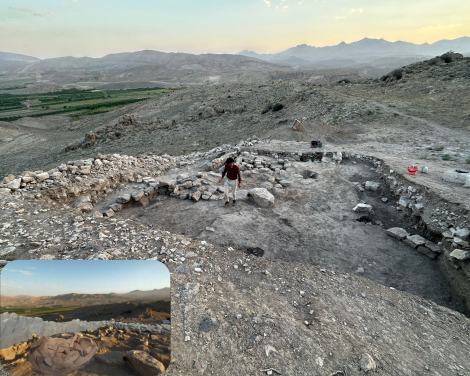
The Ararat Plain Southeast Archaeological Project site. What exists in the real world, and (small photo) the view from within the MR headset, where both a grey stone wall and a brown pottery vessel are virtually visible in their original positions, even though they were actually removed a year earlier. (Photo credit: HKU Faculty of Arts)
Archaeologists from the Faculty of Arts at the University of Hong Kong (HKU) are revolutionising the excavation and documentation of ancient sites with cutting-edge 3D immersive technologies.
Archaeology studies the human past through the excavation of things people made and used thousands of years ago – from architecture to objects like pottery bowls and animal bones from meals. Although many excavation projects create digital 3D models of what they uncover, archaeologists need new ways to meaningfully use those data. Some projects share 3D models with the public as tourism and teaching tools – one may have recently seen 3D displays at museums. However, archaeologists themselves have not yet taken full advantage of these models in their own fieldwork and research. That is about to change!
By wearing Mixed and Augmented Reality (MR/AR) headsets while actively digging, the HKU team is pioneering the interactive application of digital 3D scientific data at archaeological sites. MR headsets enable users to effortlessly view and interact with both the real world and 3D models integrated within it, using devices such as the Microsoft HoloLens 2 and the Meta Quest Pro. On the other hand, AR smart glasses display information on a small screen within the lenses and are equipped with cameras and microphones for hands-free data collection.
These technologies play a crucial role in the field of archaeology, often regarded as a 'destructive science', where data collection involves the excavation and removal of artifacts, preventing anyone else from digging the same place again.
The HKU team innovatively applied the technologies in their fieldwork project in the South Caucasus country of Armenia, where the team often removes ancient stone walls and pottery vessels to uncover earlier remains beneath. Professor Peter J. Cobb, an archaeologist at the HKU Faculty of Arts, emphasised the benefits of the new technology, stating: "By wearing an MR device while I dig, I can virtually see a removed wall at its original location. This helps me decide where to dig next, and I can compare, in situ, multiple sections of ancient architecture that were removed at different times."
Additionally, the team uses AR smart glasses for basic data recording such as capturing photographs and using voice recognition for notetaking. Professor Cobb pointed out that "Archaeologists must have their hands free while recording data, since we need to hold our trowels and brushes while digging."
HKU Faculty of Arts PhD candidate Mr Hayk Azizbekyan, who leads this research and is from Armenia himself, explained: "MR and AR headsets have never been used before at an actual archaeological excavation project to support the digging work of a team, this is our game-changing innovation! I'm excited to experiment with future ways of studying old things and preserving cultural heritage. We call this project our 'vision for the future', since the technology enables new ways of 'viewing' the past'".
The team also employs an MR headset to compare 3D scanned ancient pottery sherds with physical ones, aiding in the analysis of inaccessible artifacts displayed in museums. They anticipate that in the future, AI will facilitate the matching of these sherds based on their shapes.
These groundbreaking achievements were recently published in the Journal of Computer Applications in Archaeology (JCAA), ranked 8th out of over 350 archaeology journals in the world, by Scopus.
Professor Cobb noted: "It was interesting, the journal faced a challenge finding peer reviewers since our approach was so novel." He also led a discussion on these innovations at the Institute for the Study of the Ancient World (ISAW) of New York University (NYU) on November 13, 2024.
This interdisciplinary research collaboration bridges the gap between humanities and engineering, driven by the team's passion for advancing the field of archaeology through a unique Arts-Tech partnership with HKU engineers. The Tam Wing Fan Innovation Wing of the HKU Faculty of Engineering provided equipment and know-how. Recognizing the limitations of existing MR/AR headsets, the interdisciplinary team is now developing custom smart glasses for future fieldwork seasons.
About the Ararat Plain Southeast Archaeological Project (APSAP)
Technological experimentation is central to HKU's fieldwork project in Armenia, conducted in collaboration with the Institute of Archaeology and Ethnography, National Academy of Sciences, Republic of Armenia (IAE, NAS, RA). APSAP researches the Vedi River Valley of Armenia, situated within the Ancient Near East – the area of the world that saw the first agriculture, states, cities, and writing. APSAP excavates the 3500-year-old Vedi Fortress and deploys advanced technologies to discover new archaeological sites. In support of APSAP's advanced digital documentation efforts, HKU Faculty of Architecture Professor Guillaume Othenin-Girard has designed an innovative laboratory building, which he describes as "integrating the requirements of cutting-edge recording technologies with the historical architectural heritage of Armenia". APSAP also offers a unique educational opportunity for HKU students to travel to the South Caucasus, earning academic credit from an HKU course that is the subject of pioneering educational research by Professor Juuso H. Nieminen of HKU's Faculty of Education.
To view the article from the open access Journal of Computer Applications in Archaeology (JCAA): https://doi.org/10.5334/jcaa.140.
To view a video, produced by the HKU Knowledge Exchange Office, about the APSAP project's work with 3D archaeology, architectural innovation, and educational research: https://youtu.be/YMKJR1b94Z4






